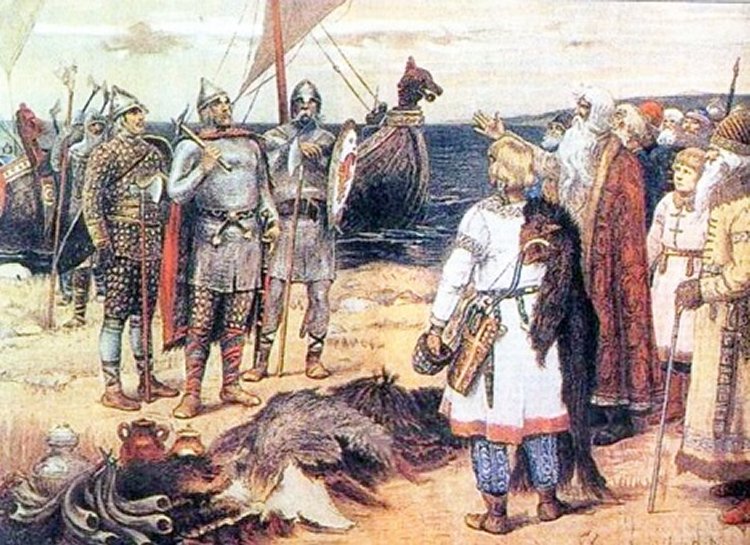Jelling Stone And Legendary Harald ‘Bluetooth’ King Of Denmark – ‘Who Made The Danes Christian’
A. Sutherland - AncientPages.com - Harald Bluetooth was the younger son of Gorm the Old and Queen Thyra.
His father, also called Gorm the Languid, was the first historically recognized King of Denmark, reigning from c. 936 to his death in c. 958. Harald was also the father of Svein Forkbeard and the grandfather of Cnut.
The German historian, Adam of Bremen, mentions that Harald Blåtand was married to Queen Gunhild. On a runestone standing at Sønder Vissing Church south of Silkeborg, a woman calls herself Tove as "Mistivoj's daughter, wife of Harald the Good, Gorm's son," so Harald must have been married twice.
The year of Bluetooth's birth is unknown; however, according to records of his achievements, he was born sometime around 920 AD, according to ancient sources.
Harald "Bluetooth" Gormsson was King of Denmark for nearly 30 years, beginning in approximately 958 AD when his brother and favored son of Gorm the Old was killed in England during attacks near Ireland.
This 12th-century gilt plate from Tamdrup Church in Denmark is the oldest illustration of King Harald Bluetooth's baptism. Image credit: Sven Rosborn - CC BY-SA 3.0 DEED
During his reign, Bluetooth united the outlying tribes of Denmark. He defended his people from many Norwegian and German incursions while overseeing the completion of vast construction projects that strengthened his country's defenses.
He proved to be a skilled leader of his nation both on and off the battlefield. Bluetooth is equally known for casting off the Norse pagan traditions and becoming a devout Christian who strove to convert the people of Denmark peacefully during his rule. He also commissioned many important construction projects in his country during his reign.
The Danes were united and Christianized in about 965 by King Harald "Bluetooth" Gormsson (c. 935 to c. 986; King of Denmark c. 958 to c. 986; King of Norway c. 970 to 986).
Bluetooth's legacy includes so-called "runestones" - monuments that usually honor the dead and their deeds. He used the very best counselors and artisans for the job. Two people carved the stone: the decorations came first, and then the runes were struck by a runic craftsman. The entire job took about a full year to complete.
Bluetooth wanted to be remembered for specific achievements, so he erected a runic stone intended to last forever.
He converted to Christianity in 965 and erected a runestone in Jelling with the inscription:
"... Harald who conquered for himself the whole of Denmark and Norway and made the Danes Christian."
"There are also two massive burial mounds at Jelling. Apart from a silver goblet, the northern burials had been removed, but excavations in Jelling church in the 1970s located a 10h-century chamber containing a disarticulated male skeleton. It is now believed that the northern mound was erected by Harald c.959 as a memorial to his parents, along with the rune stone." 1
"After his conversion, he had them removed to the church and also erected the southern mound, which became a cenotaph memorial to himself. Harald is credited with several massive public works, which should be viewed in the context of the Danish conflict with the German Emperor.
Left: A big lion with leaf-and-tendril ornamentation can be seen on King Harald Bluetooth’s great runestone from the 960s in Jelling.; Right: The larger Jelling stone, showing the inscription concerning Harald Bluetooth.
"In 968, he linked the Danevirke to Hedeby and extended and rebuilt it with a timber rampart. In 979-80, he built a large bridge over the Vejle River valley at Ravning Enge. The roadway was 720 meters long and 5.5 meters wide, supported by more than 1,500 oak timbers, and must have been intended as a military road.
In the 980s, he built a series of circular fortresses at strategic locations throughout his kingdom - they are named after the example at Trelleborg in Sjrelland, but there are other examples at Fyrkat in central Jutland, Nounebakken on Fyn, and an unfinished one at Aggersborg from the tip of northern Jutland. Each of the forts was constructed to a regular geometric blueprint..." 1
"... Harald who conquered for himself the whole of Denmark and Norway and made the Danes Christian." - Inscription on the Jelling Stone.
The large Jelling stone is Scandinavia's largest and most impressive rune stone, also called "Danmark's Baptism Certificate." It is equipped with Christian symbols, i.e., a figure of Christ and runic writing.
Writing page on the large rune stone:
![]()
Haraltr kunukr bath kaurua
Harald konge bød gøre
![]()
kubl thausi aft kurm fathur sin
kumler disse efter Gorm fader sin
![]()
auk aft thaurui muthur sina sa
og efter Thyra moder sin, den
![]()
haraltr ias sar uan tanmaurk
Harald som sig vandt Danmark
![]()
ala auk nuruiak
al og Norge
![]()
auk tani karthi kristna
og danerne gjorde kristne
This runestone is today considered the most well-known example of runic inscriptions in Denmark. Featuring an easily distinguished image of Christ on the cross, the Jelling Stone erected by Bluetooth is often referred to as the "Baptism Certificate of Denmark," which symbolizes the end of the polytheistic traditions followed by much of the Danish population.
Harald also honored his parents by commissioning a second Jelling Stone, found in the town of Jelling, Denmark.
Harald "Bluetooth" Gormsson died of wounds received in an uprising against him in 985 or 986.
Written by A. Sutherland - AncientPages.com Staff Writer
Updated on Apr 2, 2024
Copyright © AncientPages.com. All rights reserved. This material may not be published, broadcast, rewritten or redistributed in whole or part without the express written permission of AncientPages.com
Expand for referencesMore From Ancient Pages
-
 Precious Ancient Chinese Immortality Suits Made Of Jade
Artifacts | Aug 22, 2015
Precious Ancient Chinese Immortality Suits Made Of Jade
Artifacts | Aug 22, 2015 -
 Mystery Of The Ancient Red Sign Witnessed In The Sky Over Japan
News | Mar 31, 2020
Mystery Of The Ancient Red Sign Witnessed In The Sky Over Japan
News | Mar 31, 2020 -
 On This Day In History: Peasants’ Revolt First Great Popular Uprising In English History – On June 12, 1381
News | Jun 12, 2016
On This Day In History: Peasants’ Revolt First Great Popular Uprising In English History – On June 12, 1381
News | Jun 12, 2016 -
 What Happened To The Ancient Tribe That Entered A Secret Underground World And Never Came Back?
Featured Stories | Feb 1, 2021
What Happened To The Ancient Tribe That Entered A Secret Underground World And Never Came Back?
Featured Stories | Feb 1, 2021 -
 Earliest Systematic Coal Exploitation For Fuel Goes Back To ~3600 B.P.
Archaeoastronomy | Aug 2, 2023
Earliest Systematic Coal Exploitation For Fuel Goes Back To ~3600 B.P.
Archaeoastronomy | Aug 2, 2023 -
 Caganer: The Pooping Man Is Part Of The Catalonian Christmas Tradition And Nativity Scene
Ancient Traditions And Customs | Dec 17, 2017
Caganer: The Pooping Man Is Part Of The Catalonian Christmas Tradition And Nativity Scene
Ancient Traditions And Customs | Dec 17, 2017 -
 Mysterious Scorpion Goddesses In Myths And Legends
Egyptian Mythology | Jan 26, 2016
Mysterious Scorpion Goddesses In Myths And Legends
Egyptian Mythology | Jan 26, 2016 -
 On This Day In History: Army Of Tsar Alexander I Of Russia Enters Paris – On March 31, 1814
News | Mar 31, 2016
On This Day In History: Army Of Tsar Alexander I Of Russia Enters Paris – On March 31, 1814
News | Mar 31, 2016 -
 Anglo-Saxon Previously Unknown Monastic Or Trading Center – Discovered
Archaeology | Mar 7, 2016
Anglo-Saxon Previously Unknown Monastic Or Trading Center – Discovered
Archaeology | Mar 7, 2016 -
 Mystery Of The 290-Million-Year-Old Zapata Footprint In New Mexico
Featured Stories | Sep 23, 2020
Mystery Of The 290-Million-Year-Old Zapata Footprint In New Mexico
Featured Stories | Sep 23, 2020 -
 Remarkable Discovery Of A 19th-Century Boat Buried Under A Road In St. Augustine, Florida
Archaeology | Oct 16, 2023
Remarkable Discovery Of A 19th-Century Boat Buried Under A Road In St. Augustine, Florida
Archaeology | Oct 16, 2023 -
 Amazing Thirteen Ming Tombs: Gigantic Stone Animals And Human Figures Were Symbols Of Royal Power
Civilizations | Oct 1, 2018
Amazing Thirteen Ming Tombs: Gigantic Stone Animals And Human Figures Were Symbols Of Royal Power
Civilizations | Oct 1, 2018 -
 Amulets, Figurines Discovered In Recently Unearthed Limestone Sarcophagus In Minya, Egypt
Archaeology | Oct 15, 2020
Amulets, Figurines Discovered In Recently Unearthed Limestone Sarcophagus In Minya, Egypt
Archaeology | Oct 15, 2020 -
 Why Is Europe Called Europe?
Ancient History Facts | Apr 21, 2016
Why Is Europe Called Europe?
Ancient History Facts | Apr 21, 2016 -
 Ten Inscriptions Related To Sargon Unearthed At Ancient Assyrian Site In Iraq’s Kurdistan Region
Archaeology | Jan 20, 2020
Ten Inscriptions Related To Sargon Unearthed At Ancient Assyrian Site In Iraq’s Kurdistan Region
Archaeology | Jan 20, 2020 -
 Outrage In Egypt – Netflix’s Queen Cleopatra Movie Is A Falsification Of Egyptian History
Historical Figures | Apr 29, 2023
Outrage In Egypt – Netflix’s Queen Cleopatra Movie Is A Falsification Of Egyptian History
Historical Figures | Apr 29, 2023 -
 Soap Was Invented In 2800 B.C By Babylonians
Ancient History Facts | Jun 17, 2016
Soap Was Invented In 2800 B.C By Babylonians
Ancient History Facts | Jun 17, 2016 -
 Genetic Evidence Retrieved From 800,000-Year-Old Human Tooth
Human Beginnings | Apr 2, 2020
Genetic Evidence Retrieved From 800,000-Year-Old Human Tooth
Human Beginnings | Apr 2, 2020 -
 Archaeologists Shed Light On The Lives Of Stone Age Hunter-Gatherers In Britain
Archaeology | Jan 20, 2023
Archaeologists Shed Light On The Lives Of Stone Age Hunter-Gatherers In Britain
Archaeology | Jan 20, 2023 -
 A Seal Impression Dated To Persian Period Discovered In The City Of David
Archaeology | Jul 3, 2020
A Seal Impression Dated To Persian Period Discovered In The City Of David
Archaeology | Jul 3, 2020




